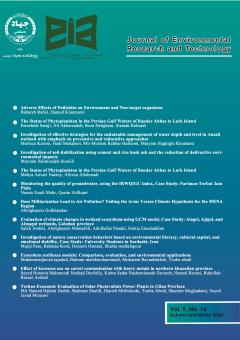Investigation of effective strategies for the sustainable management of water depth and level in Anzali wetland with emphasis on preventive and restorative approaches
Subject Areas : اقتصاد محیط زیست
morteza karimi
1
![]() ,
hadi Modabberi
2
*
,
hadi Modabberi
2
*
![]() ,
Mirmoslem Rahbar hashemi
3
,
Maryam Haghighi khomami
4
,
Mirmoslem Rahbar hashemi
3
,
Maryam Haghighi khomami
4
![]()
1 - Researcher, Department of Water Resources Monitoring, Environmental Research Institute, Academic Center for Education Culture & Research (ACECR), Rasht, Iran
2 - Assistance Professor, Department of Water Resources Monitoring, Environmental Research Institute, Academic Center for Education Culture & Research (ACECR), Rasht, Iran
3 - Instructor, Department of Water Resources Monitoring, Environmental Research Institute, Academic Center for Education Culture & Research (ACECR), Rasht, Iran
4 - Assistance Professor, Department of Water Resources Monitoring, Environmental Research Institute, Academic Center for Education Culture & Research (ACECR), Rasht, Iran
Keywords: Water level stabilization, Depth, Anzali wetland, Restoration approach, Preventive approach, Sustainable management,
Abstract :
Wetlands are complex and valuable ecosystems that host a wide range of organisms. Preserving such sensitive ecosystems and maintaining their environmental, economic, and social functions require determining their ecological water needs. The aim of this study is to examine possible methods for the sustainable management of the water depth and level in the wetland and to provide suitable strategies accordingly. Given that the water level of Anzali Wetland is hydraulically affected by the Caspian Sea level and the discharge of the rivers flowing into it, this study seeks to identify and analyze the key factors contributing to the reduction in the wetland's depth and level. It further evaluates various structural and non-structural strategies through comprehensive studies and presents appropriate options for sustainable wetland management. Accordingly, this study investigates both preventive and restorative strategies to enhance the depth and water level of the wetland, aiming to preserve and restore its ecological functions and sustainability. In the preventive approach, actions such as monitoring and preventing unauthorized water extraction, controlling erosion and sedimentation, implementing biological and mechanical watershed management operations, rehabilitating sediment traps, constructing check dams in rivers to increase basin concentration time, and managing incoming pollutants to the wetland have been considered. In the restorative approach, strategies such as hydrodynamic modeling of Anzali Wetland within a comprehensive planning framework, improving irrigation network water-use efficiency, environmentally-assessed dredging operations, combating invasive plant species, and feasibility studies of structural interventions for regulating and stabilizing the wetland’s water level have been addressed. This research ultimately aims to support the preservation and rehabilitation of the wetland’s functions and its ecological sustainability.
جاودان خرد، ا. اسماعيل ساري، ع. و بهرامي فر، ن. (1390). بررسي بقاياي آفتكش¬هاي آلي پايدار در رسوبات تالاب بینالمللی انزلي، ايران. محيط. شناسي، سال و سي و پنجم، شماره 57: 23-35.
زبردست، ل. و جعفری، ه. (1390) "ارزیابی روند تغییرات تالاب انزلی با استفاده از سنجشازدور و ارائه راهحل مدیریتی"، مجله محیطشناسی، سال 37، شماره 57، صفحه 57-64.
شکوهی، ع.، مدبری، ه. و منجزی، ح. (1401). ارزيابي تأثیر رهاسازي جريان براساس دستورالعمل هاي زيست محیطي رودخانه ها بر بیلان آبي تالاب انزلي. حفاظت منابع آب و خاک. 49-31 (46) 2: 12.
عاشوری، ع. و عبدوس، ا. (1391). زيستگاههاي تالابي مهم پرندگان آبزي گيلان. کتیبه گیل. 260ص.
مدبری، ه و شکوهی، ع. (1398). تعیین نیازآبی زيست محیطی تالاب انزلی با استفاده از روشهای اكوهیدرولوژيکی. مجله تحقیقات منابع آب ایران. (3) 15: 104-91.
مدبری، ه و شکوهی، ع. (1399). ارزیابی اثرات بهرهبرداری از شبکه آبیاری و زهکشی سفیدرود بر حیات تالاب انزلی. مجله آبیاری زهکشی، دوره ،14 شماره 6. صص 1939-1953.
ميرزاجاني، ع. خداپرست، ح. بابايي، ه. عابديني، ع. و دادي قندي، ع. (1388) "روند فراغني شدن تالاب انزلي با استفاده از اطلاعات دهساله 1381-1371 "، مجله محیطشناسی، سال 35، شماره 52. صص 65-73.
Agarwal, A., M. S. delos Angeles, R. Bhatia, I. Chéret, S. Davila-Poblete, M. Falkenmark, F. G. Villarreal, T. Jønch-Clausen, M. A. Kadi, and J. Kindler. (2004) Integrated Water Resources Management, Global Water Partnership, Denmark.
Arthington, A.H., S.O. Brizga and M.J. Kennard. (1998) Comparative evaluation of environmental flow assessment techniques: best practice framework. Report OP 25/98. Land and Water Resources Research and Development Corporation, Canberra.
Guo, H. C., Liu, L., Huang, G. H., Fuller, G. A., Zou, R., & Yin, Y. Y. (2001). A system dynamics approach for regional environmental planning and management: A study for the Lake Erhai Basin. Journal of Environmental Management, 61(1), 93–111. https://doi.org/https://doi.org/10.1006/jema.2000.0400
JICA, DOE, MOJA. (2005) The study on integrated management for ecosystem conservation of the Anzali Wetland in the Islamic Republic of Iran, Draft final report Vol. II: Maim report, Nippon Koei Co. 150p.
Mostert, E., E. Van Beek, N. W. M. Bouman, E. Hey, H. H. G. Savenije & W. A. H. Thissen, (2000) ‘River Basin Management and Planning. In Mostert, E. (ed), Riber Basin management; Proceedings of the International Workshop’ (The Hage, 27-29 October 1999). UNESCO, 24-55.
Smakhtin, V., Revenga, C., & Döll, P. (2004). A Pilot Global Assessment of Environmental Water Requirements and Scarcity. Water International, 29(3), 307–317. https://doi.org/10.1080/02508060408691785
Wałęga, A., Kędzior, R., Skalski, T., & Młyński, D. (2025). A Global hydrological index describes ecological conditions in rivers: A new approach to environmental flow calculation reflecting macroinvertebrate requirements. Ecological Indicators, 170, 113082. https://doi.org/https://doi.org/10.1016/j.ecolind.2025.113082
Wan, F., Zhang, F., Zheng, X., & Xiao, L. (2022). Study on ecological water demand and ecological water supplement in wuliangsuhai lake. Water, 14(8), 1262.
Yang, T., Wang, S., Li, X., Wu, T., Li, L., & Chen, J. (2018). River habitat assessment for ecological restoration of Wei River Basin, China. Environmental Science and Pollution Research, 25(17), 17077–17090. https://doi.org/10.1007/s11356-018-1774-z
Yang, Y., Yin, X., & Yang, Z. (2016). Environmental flow management strategies based on the integration of water quantity and quality, a case study of the Baiyangdian Wetland, China. Ecological Engineering, 96, 150–161. https://doi.org/https://doi.org/10.1016/j.ecoleng.2015.12.018

